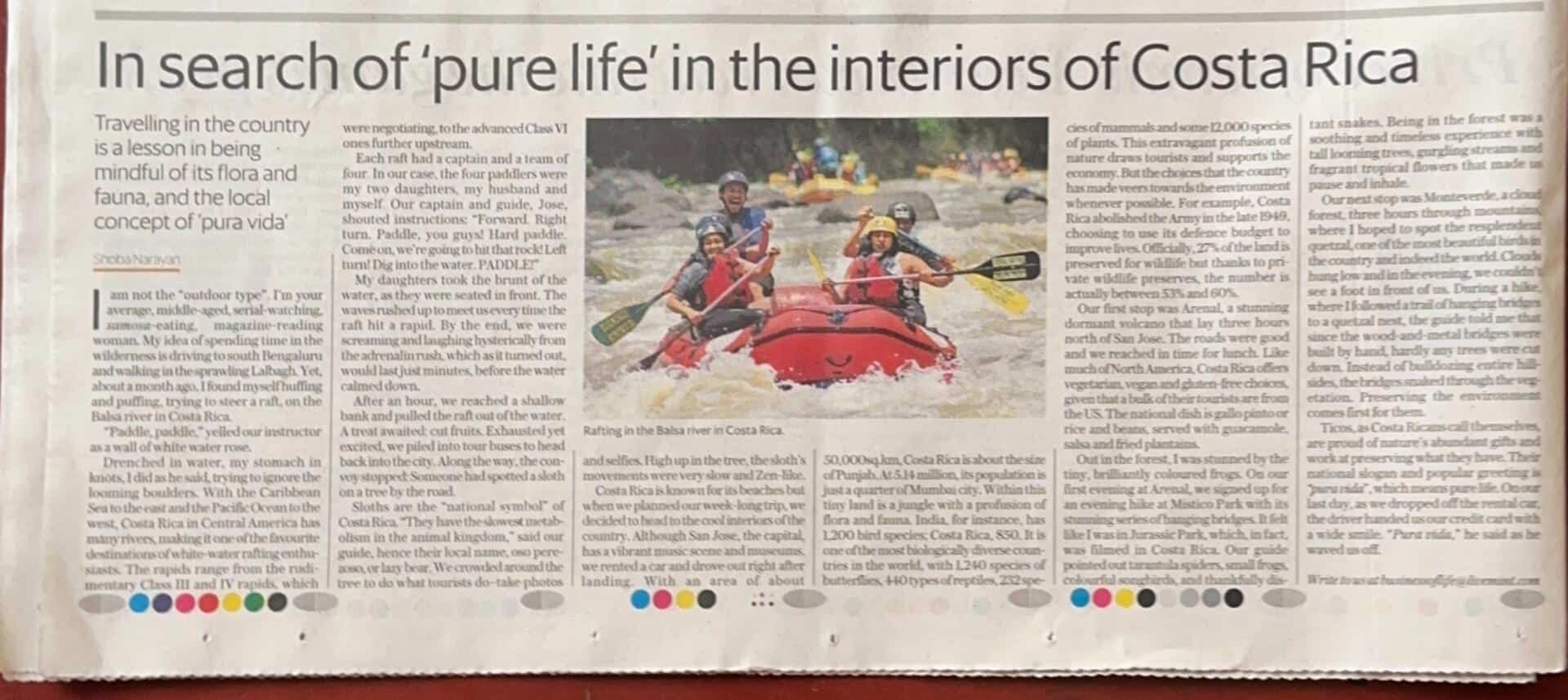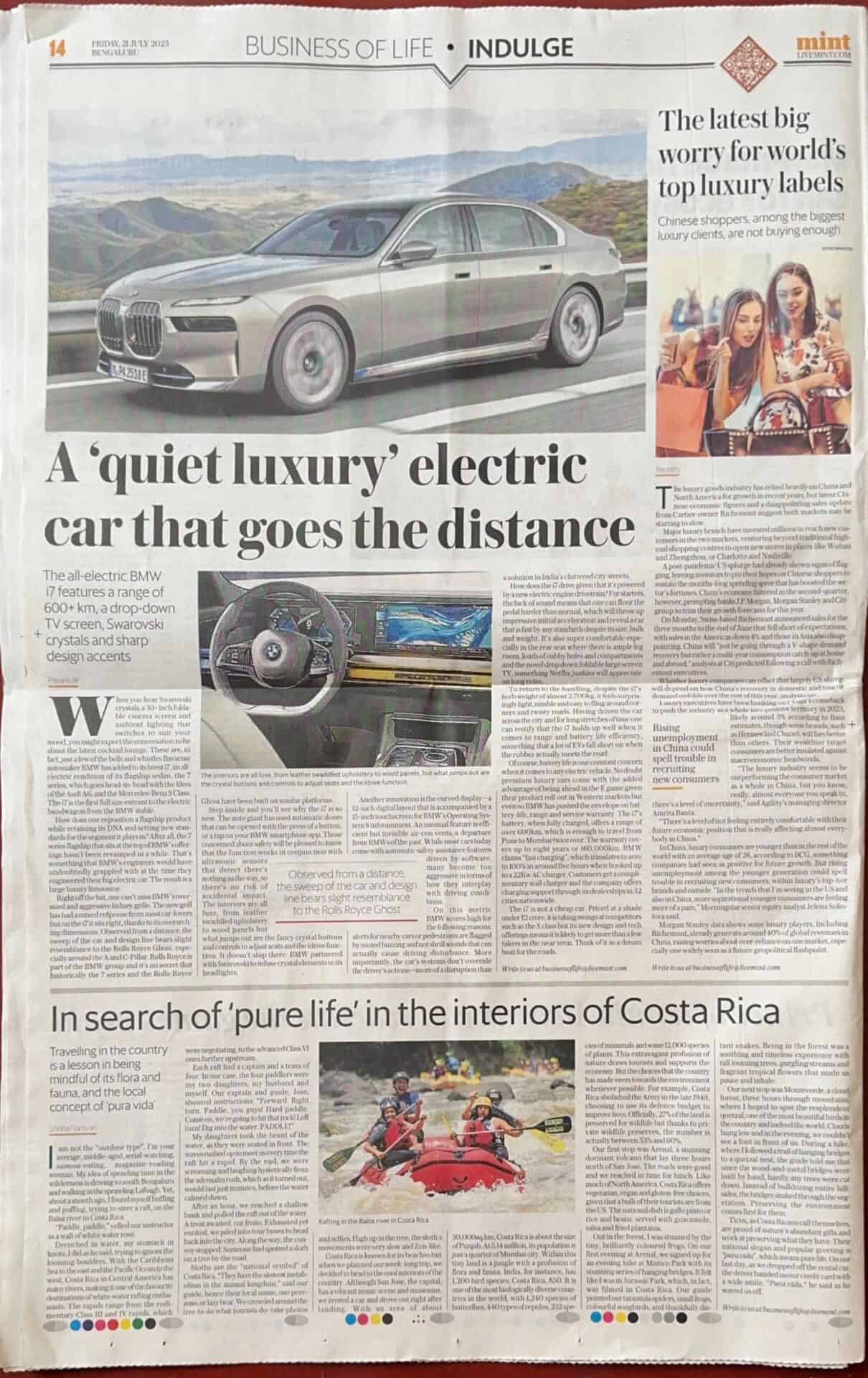Travelling in Costa Rica is a lesson in being mindful of its beautiful animal, bird and insect life and the local concept of ‘pura vida’ or pure life

Below is a more expansive version of the piece I wrote for Mint Lounge
You have to know me to realize this, but something I did last month was pretty crazy. I mean, looking back, it was wonderful. I talk about it all the time, tell my friends that they ought to do it, that sort of thing. But when I actually did it! Talk about insanity!
One thing I have to tell you right off is that I’m not what they call an “outdoor-type.” I’m just your average, middle-aged, serial-watching, samosa-eating, magazine-reading Mom. My idea of experiencing the wilderness is to have the kids in my building visit my apartment at 7 a.m. on a peaceful Sunday.
Yet, there I was, huffing and puffing along some God-forsaken river in the middle of Costa Rica with a bunch of folks who looked like they were born yesterday. Instead of patching marriages, or sorting out mid-life crises like any self-respecting Bangalorean, I was with my family on an adventurous outdoorsy holiday in this Central American country.
“Paddle. Paddle,” yells our instructor as a wall of white water rises in front.
Drenched in water, my stomach in knots, I do as he says, trying to ignore the looming boulders in front.
The rapids are amazing- large, churning, powerful masses of quick-flowing, white-water. Each raft had a captain and four paddlers. In our case, the four paddlers are my two daughters, my husband and me. Our captain is our guide, Jose, who keeps on yelling, “Forward. Right turn. Paddle, you guys! Hard paddle. Come on, we’re going to hit that rock! Left turn! Dig into the water. PADDLE!”
The front sea gets the brunt of the water. The raft goes into a rapid, and all you are aware of is these huge waves that are rushing straight at your face. The captain is screaming, you are bending over the waves to “dig in,” and trying to keep your balance at the same time. You get totally drenched, the boat tosses up and down like a see-saw, you find yourself screaming and laughing hysterically. It’s an adrenaline rush. Within minutes, the water is calm, and it is all over.
Finally, we reach calm waters and pull the raft to the riverbank. A treat awaits: cut fruits. Some hundred of us gather around the rafts to dig into the fruits. Finally, exhausted, we pile into tour buses to head back into the city. Along the way, the entire convoy stops. Someone has spotted a sloth bear on the side of the road.
Sloths may be slow animals, but they surely make their way throughout Costa Rica. Their leisurely ways seem quite suited to the pura vida here, and no doubt gave rise to their name in Spanish: oso perezoso, literally “lazy bear.”
The country is home to two of the four sloth species: the three-toed and the two-toed sloths. They are present on the Pacific and Caribbean slopes in both pristine and disturbed forests.
We had no idea about this when we landed in San Jose, the capital. Having driven all over the world, my husband and I decide to rent a car for a week-long trip. While all the global operators like Hertz and Avis have operations in Costa Rica, we choose a local company, Adobe Rent-a Car because they offered the best value for money. From the airport, an Adobe shuttle took us to their offices where we had booked an SUV online. Since we were going to rainforests rather than beaches, we opted for a 4X4 in case of steep mountain climbs. We were glad we did. While Costa Rica has good roads and highways, the forests we visited required driving on unpaved roads.
First-time tourists usually choose between forests and beaches. Nature is a constant everywhere. We opted for the forests. Our first stop was Arenal, a stunning dormant volcano that lay three hours north of San Jose. The roads were good and we reached in time for lunch. Like much of North America, Costa Rica too caters to vegetarian, vegan, and even gluten-free choices given that a bulk of their tourists are from the United States. As vegetarians, we had no problems. The national dish is gallo pinto or rice and beans, served with guacamole, salsa and fried plantains. I ended up eating this with scrambled eggs for breakfast every morning.
In Costa Rica, everyone talks about taking night hikes given the profusion of frogs and nocturnal insects. On our first evening at Arenal, we sign up for an evening hike at Mistico Park with its stunning series of hanging bridges. We begin in the evening and continue till dark. It feels like being in Jurassic Park, which in fact was filmed in Costa Rica. Our guide points out tarantula spiders, small frogs, colourful songbirds, and thankfully distant snakes. Being in the forest is a soothing and timeless experience with tall graceful trees, gurgling streams and fragrant tropical flowers that make us pause and inhale. After a few hours inside the forest, we return to the Arenal Observatory Lodge, rejuvenated.
Over the next few days, we hike, go white-water rafting, and spend the evenings trying out restaurants in La Fortuna, the closest town. Before we know it, we have to drive to Monteverde, a cloud forest, three hours through mountains. We are going there because I want to see the Resplendent Quetzal, one of the most beautiful birds in the country and indeed the world.
Monteverde is smaller but equally stunning. Cloud hangs low. During our walk through several reserves, we meet tourists from the US, Canada and Europe. Some have come to Monteverde twice, drawn by its fame as a birding destination. During the afternoon, it rains. Thankfully, our hotel, The Senda, has a rotating list of activities including a workshop on medicinal teas using local herbs, a cocktail classes, and nature talks about the monkeys and snakes of Costa Rica. One theme that keeps coming up is environmental sustainability.

With an area of about 50,000 square kilometres, Costa Rica is about the size of Punjab. It’s population of 5.14 million is quarter of just Mumbai city. Within this tiny land is a jungle with a profusion of flora and fauna. India for instance, has 1200 bird species; Costa Rica has 850. It is one of the most biologically diverse countries in the world with 1240 species of butterflies, 440 types of reptiles, 232 species of mammals and some 12,000 species of plants.
This extravagant profusion of nature draws tourists and supports the economy. But the choices that the country has made veers towards the environment whenever possible. At Sky Adventures in Monteverde where I followed a trail of hanging bridges to a quetzal nest, the guide told me that since the bridges were built by hand, hardly any trees were cut down to built them across the forest.
Ticos (as Costa Ricans call themselves) are proud of nature’s abundant gifts and work at preserving what they have. Their lifestyle epitomises the national slogan and frequent greeting: Pura Vida or Pure Life.





Leave A Comment